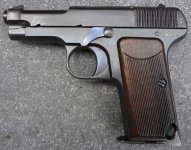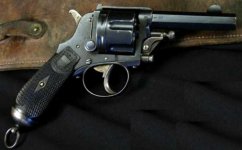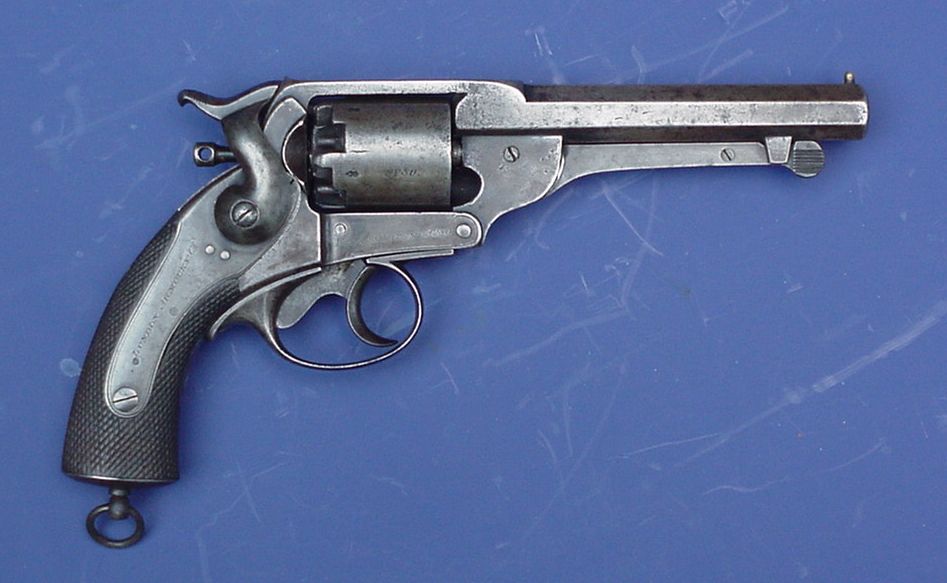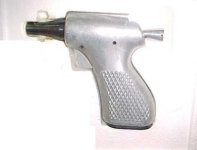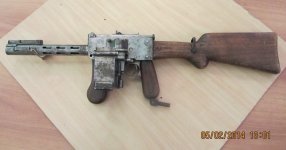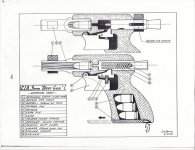You are using an out of date browser. It may not display this or other websites correctly.
You should upgrade or use an alternative browser.
You should upgrade or use an alternative browser.
What the heck
- Thread starter Ozzieman
- Start date
At least it lasted an hour.
Scorch I was just shutting down my computer and decided to look one last time and WAM
85 Pietro Beretta M1915 Pistol - 7.65mm Variant
https://en.wikipedia.org/wiki/Beretta_M1923
When Italy entered World War I, the need for more military pistols increased dramatically. In 1915, Tullio Marengoni from Beretta completed his design of a simple blowback action pistol that could fire the same 9mm Glisenti cartridge. This pistol was adopted by the Italian Army as the M1915. The M1915 is unusual in the fact that it used 2 manual safeties. One is a slide stop safety on the left side of the frame. The other is a small lever on the rear of the frame. If either safety is set, the pistol will not fire. Also manufactured by Beretta and adopted by the Italian military was a scaled-down version of this pistol in 7.65mm. In addition to being smaller, it did not have the manual safety at the rear of the frame.
In 1919 improvements were made in the 7.65mm M1915 design. The round post barrel mount where the barrel was lifted straight up out of the frame was replaced with a T slot mount. This required a larger opening in the top of the slide so the double opening of the M1915 was changed to a single longer one. The slide now looked like the open topped style still used by Beretta to this day. The redesigned pistol is marked on the slide 1915 - 1919.
Scorch I was just shutting down my computer and decided to look one last time and WAM
85 Pietro Beretta M1915 Pistol - 7.65mm Variant
https://en.wikipedia.org/wiki/Beretta_M1923
When Italy entered World War I, the need for more military pistols increased dramatically. In 1915, Tullio Marengoni from Beretta completed his design of a simple blowback action pistol that could fire the same 9mm Glisenti cartridge. This pistol was adopted by the Italian Army as the M1915. The M1915 is unusual in the fact that it used 2 manual safeties. One is a slide stop safety on the left side of the frame. The other is a small lever on the rear of the frame. If either safety is set, the pistol will not fire. Also manufactured by Beretta and adopted by the Italian military was a scaled-down version of this pistol in 7.65mm. In addition to being smaller, it did not have the manual safety at the rear of the frame.
In 1919 improvements were made in the 7.65mm M1915 design. The round post barrel mount where the barrel was lifted straight up out of the frame was replaced with a T slot mount. This required a larger opening in the top of the slide so the double opening of the M1915 was changed to a single longer one. The slide now looked like the open topped style still used by Beretta to this day. The redesigned pistol is marked on the slide 1915 - 1919.
Mike Irwin
Staff
And besides, I identified the Bodeo revolver pages and pages ago.
That particular one is one of the later closed frame variants.
That particular one is one of the later closed frame variants.
Sorry if I did this one before but Scorch got that one right.
84 Italian Bodeo M1889 Revolvers Chamelot Delvigne Police Revolver
https://en.wikipedia.org/wiki/Bodeo_Model_1889
The Bodeo Model 1889 revolver (Italian: Pistola Rotazione, Sistema Bodeo, Modello 1889) was named after the head Italian firearm commission Carlo Bodeo. It was produced by a wide variety of manufacturers between 1889 and 1931 in both Spain and Italy. It was employed by the Royal Italian Army in World War I, the Interwar Italian colonial wars, and World War II. The Bodeo comes in two distinct varieties with only superficial weapons differences
Made by a large variety of Italian gunmakers, the Bodeo became the service revolver of the Italian Army in 1891.[2] The revolver was named after the head of the Italian commission that recommended its adoption Carl Bodeo.[3] It remained the principle handgun of the Italian Army until it was increasingly supplanted by the Glisenti Model 1910.[2] The revolver was never declared obsolete and remained as a reserve weapon until the end of World War II.[4] Among the Italian manufacturers identified with the production of the Bodeo include, Societa Siderurgica Glisenti, Castelli of Brescia, Metallurgica Bresciana, and Vincenzo Bernardelli of Gardone Val Trompia.[5] During World War I, Spanish manufacturers, Errasti and Arrostegui of Eibar produced the Bodeo for the Italian government.[5] The Italians nicknamed this revolver coscia d’agnello ("leg of lamb"). During World War II the Wehrmacht designated the Bodeo Revolver 680(i) when utilized as an alternative firearm
The Bodeo Model 1889 is a solid-framed, six-shot revolver.[5] The revolver was designed in two distinct versions: a round-barreled version designed with a trigger guard, and an octagonal-barreled version with a folding trigger.[3] The octagonal-barreled version was produced for rank and file Italian soldiers while the round-barreled version was produced for non-commissioned officers and field officers.[5] The folding trigger version was produced in greater number.[4]
Mechanics[edit]
The Bodeo was considered simple and robust.[3] Because the revolver was made by a wide variety of manufacturers, the quality of the weapon varied greatly with frames being made from a wide variety of materials ranging from brass to brazed copper plates.[7] The gate was connected to the hammer[4] and the barrel was screwed into the frame.[3] Ejection was achieved by the rod normally housed in the hollow axis pin.[3] The hammer block was designed to prevent firing unless the trigger was pulled fully back.[4]
84 Italian Bodeo M1889 Revolvers Chamelot Delvigne Police Revolver
https://en.wikipedia.org/wiki/Bodeo_Model_1889
The Bodeo Model 1889 revolver (Italian: Pistola Rotazione, Sistema Bodeo, Modello 1889) was named after the head Italian firearm commission Carlo Bodeo. It was produced by a wide variety of manufacturers between 1889 and 1931 in both Spain and Italy. It was employed by the Royal Italian Army in World War I, the Interwar Italian colonial wars, and World War II. The Bodeo comes in two distinct varieties with only superficial weapons differences
Made by a large variety of Italian gunmakers, the Bodeo became the service revolver of the Italian Army in 1891.[2] The revolver was named after the head of the Italian commission that recommended its adoption Carl Bodeo.[3] It remained the principle handgun of the Italian Army until it was increasingly supplanted by the Glisenti Model 1910.[2] The revolver was never declared obsolete and remained as a reserve weapon until the end of World War II.[4] Among the Italian manufacturers identified with the production of the Bodeo include, Societa Siderurgica Glisenti, Castelli of Brescia, Metallurgica Bresciana, and Vincenzo Bernardelli of Gardone Val Trompia.[5] During World War I, Spanish manufacturers, Errasti and Arrostegui of Eibar produced the Bodeo for the Italian government.[5] The Italians nicknamed this revolver coscia d’agnello ("leg of lamb"). During World War II the Wehrmacht designated the Bodeo Revolver 680(i) when utilized as an alternative firearm
The Bodeo Model 1889 is a solid-framed, six-shot revolver.[5] The revolver was designed in two distinct versions: a round-barreled version designed with a trigger guard, and an octagonal-barreled version with a folding trigger.[3] The octagonal-barreled version was produced for rank and file Italian soldiers while the round-barreled version was produced for non-commissioned officers and field officers.[5] The folding trigger version was produced in greater number.[4]
Mechanics[edit]
The Bodeo was considered simple and robust.[3] Because the revolver was made by a wide variety of manufacturers, the quality of the weapon varied greatly with frames being made from a wide variety of materials ranging from brass to brazed copper plates.[7] The gate was connected to the hammer[4] and the barrel was screwed into the frame.[3] Ejection was achieved by the rod normally housed in the hollow axis pin.[3] The hammer block was designed to prevent firing unless the trigger was pulled fully back.[4]
globemaster3
New member
That looks like some kind of glue gun!
That's a real firearm?
That's a real firearm?
OK, I'll confess. But I didn't know there were any witnesses!If anyone can figure out what this is they get 1,000,000 points because I have NO idea
Mike Irwin
Staff
Wow. Haven't seen a picture of the Vietnam-era Deer gun in years...
Sort of a follow-on to the WW II Liberator. About as useful (as in, never used), but in the case of the Deer gun, only about 1,000 were made, as opposed to over 1 million Liberators.
Sort of a follow-on to the WW II Liberator. About as useful (as in, never used), but in the case of the Deer gun, only about 1,000 were made, as opposed to over 1 million Liberators.
Mike Irwin
Staff
And the one for which you have no clue?
German 08/18 Maxim SMG. Completely funky design, which fed from a multi-column magazine that held 80 rounds in 10 columns.
The magazine indexed as each column emptied.
German 08/18 Maxim SMG. Completely funky design, which fed from a multi-column magazine that held 80 rounds in 10 columns.
The magazine indexed as each column emptied.
Mike I am impressed
565 Deer gun
https://en.wikipedia.org/wiki/Deer_gun
The Deer gun was a successor to the Liberator pistol, developed by the CIA. The single-shot Deer gun was intended for distribution to South Vietnamese guerrillas as a weapon against North Vietnamese soldiers.[1]
Design[edit]
The Deer gun was made of cast aluminum, with the receiver formed into a cylinder at the top of the weapon. The striker protruded from the rear of the receiver and was cocked in order to fire, and a plastic clip was placed there to prevent an accidental discharge, as the Deer gun had no mechanical safety. The grip had raised checkering, was hollow, and had space for three 9 mm rounds and a rod for clearing the barrel of spent cases. The Deer gun lacked any marking identifying manufacturer or user, in order to prevent tracing of the weapons, and all were delivered in unmarked polystyrene boxes with three 9 mm rounds and a series of pictures depicting the operation of the gun. A groove ran down a ramp on top for sighting. The barrel unscrewed for loading and removing the empty casing. A cocking knob was pulled until cocked. The aluminum trigger had no trigger guard.[1]
Operation[edit]
The Deer gun was loaded by removing the barrel and placing a 9 mm cartridge in the chamber. The striker was then cocked, and a small plastic clip placed around the striker to impede the forward motion of the striker to prevent accidental discharge. The barrel was then screwed back onto the receiver. The gun was fired by removing the plastic clip, placing it on the barrel where it would become the sight, and pulling the trigger. At this point the user would take the victim's equipment if opportunity presented itself, and then flee. Later, the user would reload the gun by unscrewing the barrel and ejecting the spent case with the provided barrel rod, and follow the outlined procedure.[1][2]
History[edit]
One production run of 1,000 Deer guns was made in 1964 as an initial run, with the final cost projected as US$3.95 per gun. Rather than the Vietnam war being a small clandestine war, it became a full-scale war where the Deer gun would not be as useful as foreseen. Some Deer guns were evaluated in Vietnam, but the fate of the rest is unknown. Most sources state that all were destroyed.[1][2][3]
565 Deer gun
https://en.wikipedia.org/wiki/Deer_gun
The Deer gun was a successor to the Liberator pistol, developed by the CIA. The single-shot Deer gun was intended for distribution to South Vietnamese guerrillas as a weapon against North Vietnamese soldiers.[1]
Design[edit]
The Deer gun was made of cast aluminum, with the receiver formed into a cylinder at the top of the weapon. The striker protruded from the rear of the receiver and was cocked in order to fire, and a plastic clip was placed there to prevent an accidental discharge, as the Deer gun had no mechanical safety. The grip had raised checkering, was hollow, and had space for three 9 mm rounds and a rod for clearing the barrel of spent cases. The Deer gun lacked any marking identifying manufacturer or user, in order to prevent tracing of the weapons, and all were delivered in unmarked polystyrene boxes with three 9 mm rounds and a series of pictures depicting the operation of the gun. A groove ran down a ramp on top for sighting. The barrel unscrewed for loading and removing the empty casing. A cocking knob was pulled until cocked. The aluminum trigger had no trigger guard.[1]
Operation[edit]
The Deer gun was loaded by removing the barrel and placing a 9 mm cartridge in the chamber. The striker was then cocked, and a small plastic clip placed around the striker to impede the forward motion of the striker to prevent accidental discharge. The barrel was then screwed back onto the receiver. The gun was fired by removing the plastic clip, placing it on the barrel where it would become the sight, and pulling the trigger. At this point the user would take the victim's equipment if opportunity presented itself, and then flee. Later, the user would reload the gun by unscrewing the barrel and ejecting the spent case with the provided barrel rod, and follow the outlined procedure.[1][2]
History[edit]
One production run of 1,000 Deer guns was made in 1964 as an initial run, with the final cost projected as US$3.95 per gun. Rather than the Vietnam war being a small clandestine war, it became a full-scale war where the Deer gun would not be as useful as foreseen. Some Deer guns were evaluated in Vietnam, but the fate of the rest is unknown. Most sources state that all were destroyed.[1][2][3]
Attachments
Thanks Mike
German 08/18 Maxim SMG
Interesting photos and very little information but it sure was strange coming from Germany even in 1918.
Uses a multiple box magazine that held 8 rows of 10 rounds.
Photos of the internals with the crank it looks like a device to slice potato's for a casserole.
https://www.forgottenweapons.com/experimental-german-0818-maxim-smg/
German 08/18 Maxim SMG
Interesting photos and very little information but it sure was strange coming from Germany even in 1918.
Uses a multiple box magazine that held 8 rows of 10 rounds.
Photos of the internals with the crank it looks like a device to slice potato's for a casserole.
https://www.forgottenweapons.com/experimental-german-0818-maxim-smg/

